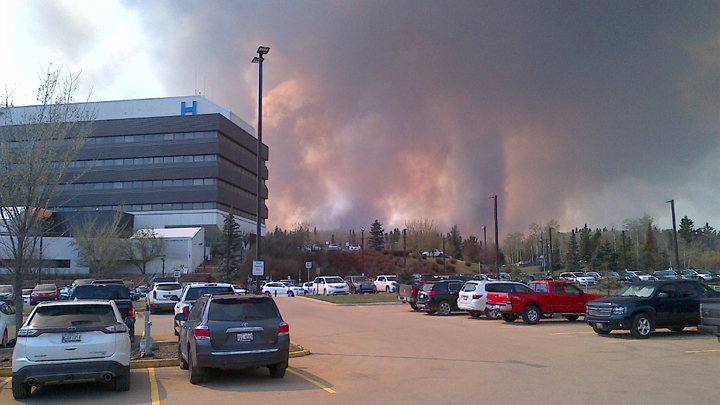
May 19, 2016

The fire was uncomfortably close when Colin Jardine left the Northern Lights Regional Health Centre.
Story by Kathryn Kranenburg; Photo by Colin Jardine
FORT MCMURRAY - As a wildfire was closing in on Fort McMurray, Colin Jardine was still hard at work at the Northern Lights Regional Health Centre.
Jardine, a local resident and Alberta Health Services’ (AHS) Director of Technology Architecture and Solutions in the Information Technology (IT) department, sent pictures of the fires above the hospital to Penny Rae, Chief Information Officer.
They made the decision at 2:00 p.m. on May 3 to send the site’s IT team home to their families to prepare for evacuation and then Jardine headed home himself to get his wife and kids safely on the road out of town.
RCMP were directing traffic north, but temporarily opened the highway south and Jardine took that opportunity to send his family to Lac La Biche; he got out of the car and walked back home to their other vehicle.
“Once I was sure my family was on the road south, it took me over 30 minutes by foot to get back to my house because of the miles of traffic blocking every roadway,” explains Jardine. While the wildfires grew, he returned to the health centre to protect the IT systems and prepare the site’s data centre for shut down and help with the evacuation of the facility.
Jardine was one of the last people to leave the hospital that day. The evacuation had been underway for hours by the time he got in his car and Jardine soon discovered how quickly the fire had moved in on Fort McMurray.
“As I left the hospital the sky overhead was a mix of black smoke and orange flames with burnt spruce needles falling down around me. Abasand Hill across the highway from the hospital was on fire and there was a house and structures across the street also on fire,” describes Jardine.
He found the roads and highway out of Fort McMurray choked with the scores of residents trying to flee and then discovered his car was nearly out of gas. He knew he wouldn’t reach Wandering River, the next stop 200 kilometers away, without topping up his tank.
As he left the city to join his family, he saw vehicles and recreational vehicles lining the ditches for miles that didn’t have enough gas to continue on. Knowing he didn’t have enough gas to make it to Wandering River, his only choice was to go a different route toward Anzac, which was closer.
In desperation, he contacted a fellow AHS IT colleague who lived just outside of Anzac and was not yet part of the evacuation zone. To his amazement, Donna Adams, a provincial manager for Health Information Management, had five gallons of gas at her home for a recreational vehicle - enough to get him back on the road to Wandering River and then on to Lac La Biche where his family awaited.
It took him six hours on the jam-packed highway to reach them. Despite his exhaustion and worry for the home and city he left behind, when he arrived Jardine jumped into action to locate the other evacuated members of his AHS team and began setting up the Lac La Biche reception centre with IT services. His wife, Shannon, had already spent the day volunteering her time in the reception centre.
Meanwhile, behind the scenes of one of the worst disasters in Alberta’s history, IT teams across AHS were mobilizing to virtually connect the displaced AHS teams with the rest of the province, so they could continue to work where they were.
“Dozens of laptops, aircards and iPads were located and driven by IT staff to the reception centres and makeshift health sites,” says Brent Trombley, AHS Senior Operating Director, Technology Services, IT. “The IT teams worked with TELUS to ensure network access was available within hours – a job that typically would have taken days to facilitate.”
Working around the clock, IT teams were able to provide reception centres in several cities and the temporary Fort McMurray Urgent Care Centre with the technology they need to function and care for thousands of residents and evacuees.
On the ground in Lac La Biche, Jardine was able to convey firsthand information about what was happening to AHS leadership and was among the first AHS staff sent back to the Fort McMurray hospital to assess status.
Nine IT members were displaced by the fires, including one who spent the night in his car on a roadside with his wife and baby after running out of gas during the evacuation. Adams, who helped Jardine escape, narrowly missed losing her home a few days after she helped get him on the road.
Putting their potential losses and frightening experiences aside, several of the displaced IT team members have banded together to provide the support needed to ensure Northern Albertans receive the health care they need.
In addition to the IT support provided , the provincial IT Clinical Services Team also collectively donated $19,443 to charities for Fort McMurray residents.